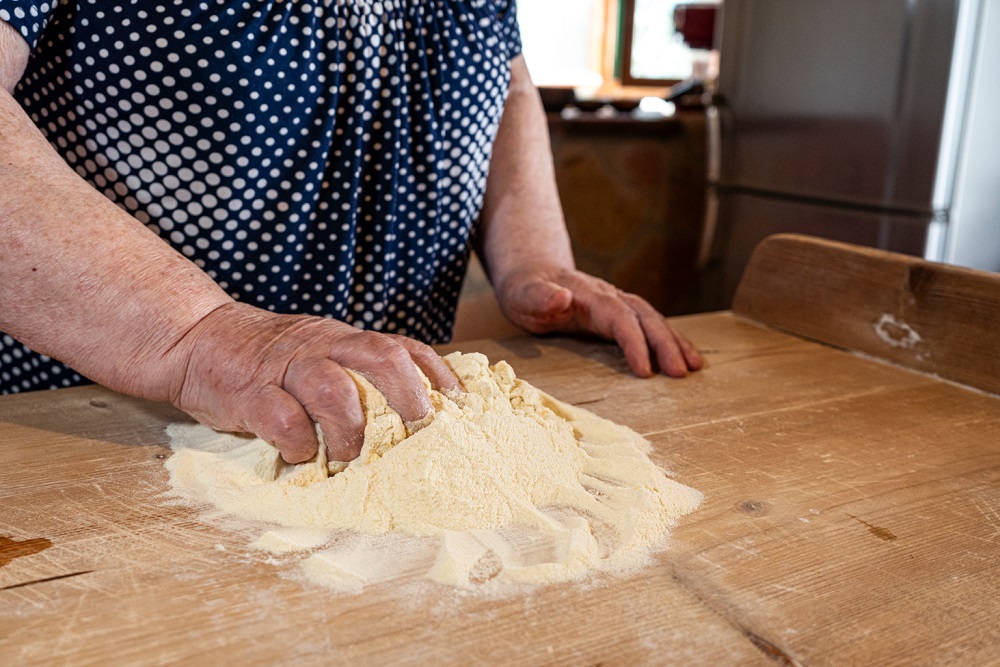Not all flours are the same: each type decisively affects taste, texture, performance in the kitchen, and nutritional value. Two key factors make the difference: the degree of refinement and the ash content, which determine how much of the original grain remains in the flour.
Indice
What distinguishes flours
Differences between one flour and another mainly depend on two factors: the degree of refinement and the ash content.
The degree of refinement indicates how much of the outer parts of the grain have been removed during milling: the more refined the flour, the lighter, whiter, and poorer in fiber it becomes.
The ash content represents the mineral residue left after controlled combustion and indicates the presence of bran and germ in the flour.
This explains why type 00 and wholemeal flour are opposites: type 00 is the most refined, with very low ash content. Its neutral taste makes it suitable for multiple recipes. Wholemeal flour, instead, retains all parts of the grain, has a high ash content, and is rich in fiber, intense aromas, and nutritional properties.
Differences between type 0 and type 00 flour
Type 00 flour, the most refined, is often called one of the “white poisons”: almost entirely stripped of bran and germ, it has lost most nutrients and fiber, making it poor nutritionally.
Type 0 flour, instead, is a better alternative: less refined, it retains part of the fiber and minerals, offering more flavor, digestibility, and health benefits. That’s why, when it comes to bread or pizza, many professionals and enthusiasts prefer type 0 over 00.
Uses and recipes with type 0 flour
Type 0 flour is recognizable by its light color and good workability, thanks to a less intensive refining process compared to 00. It is balanced and versatile, producing soft doughs with more flavor and character.
How to use type 0 flour
It is widely used for bread, pizza, focaccia, pastries, and fresh pasta.
Specific uses — hydration levels, leavening times, and kneading techniques — depend more on flour strength (W index) than on the type itself.
Examples:
- Weak type 0 (W 150–220): perfect for shortcrusts (sweet or savory), biscuits, pies, crackers, breadsticks, taralli.
- Medium type 0 (W 220–280): ideal for medium leavening doughs such as rustic bread, direct pizzas, focaccia, simple brioche, sponge cakes.
- Medium-strong type 0 (W 300–380): suitable for long fermentations and high hydration, such as contemporary pizzas, special breads, structured brioches.
- Very strong type 0 (over W 380): used for rich doughs like panettone, pandoro, colomba, babà. Its strength supports high-fat and high-sugar recipes.
Uses and recipes with wholemeal flour
Wholemeal flour is obtained by grinding the entire grain, keeping bran and germ intact. It is more nutritious, rich in fiber, vitamins, and minerals. It promotes satiety, supports digestion, and enriches the diet with rustic aromas.
Its flavor is intense, recalling freshly milled grain. Its low W index makes it unsuitable for long leavening or elastic doughs, but perfect for rustic recipes.
How to use wholemeal flour
- Alone: rustic biscuits, pies, crackers, taralli, shortcrusts, simple cakes.
- Blended with stronger flours (type 0): for bread or pizza, combining nutrition with elasticity.
More fiber means higher hydration is required, as bran absorbs more water.
The importance of autolysis in wholemeal flours
Autolysis helps improve hydration and dough elasticity when working with wholemeal flour. Mixing flour and water and resting before adding yeast and salt allows fibers to hydrate fully, enzymes to activate, and gluten to develop. The result: softer, more workable, and more digestible doughs.
Why choose èViva flours
èViva flours are:
- Free from glyphosate and pesticides.
- Milled without additives, preserving live wheat germ.
- Grown in Puglia with integrated farming, zero-residue.
- Available in a wide range: for bread, pizza, pasta, pastries, biscuits, and leavened cakes.
Choosing èViva flours means working with healthy, authentic, and high-performance flours

